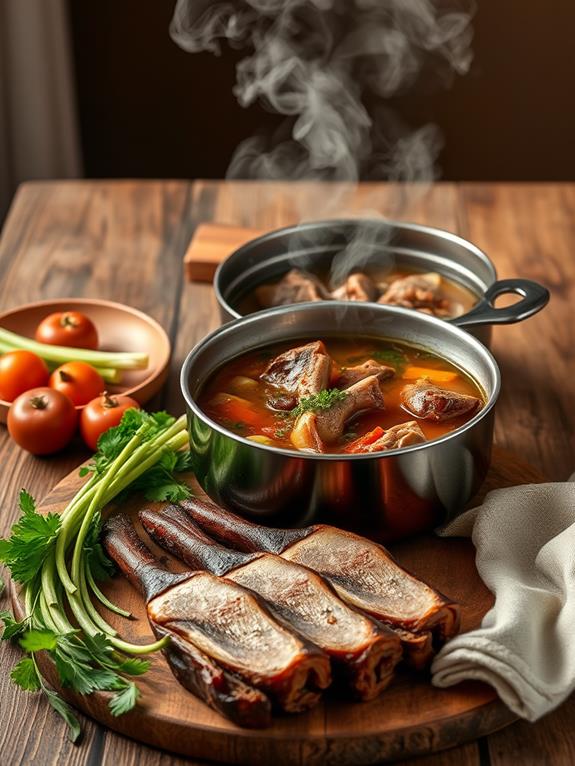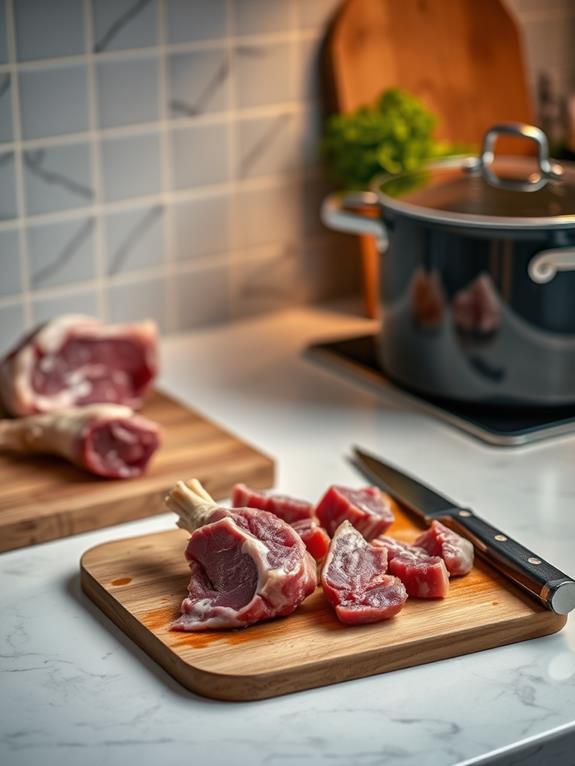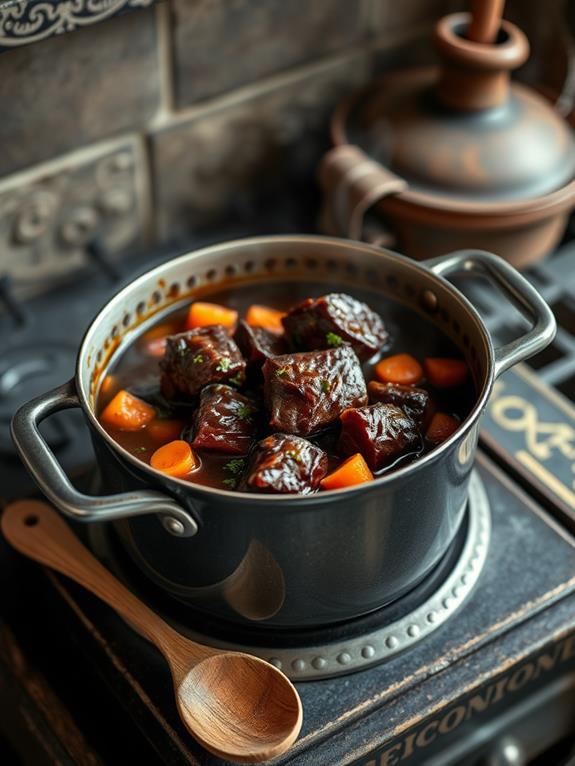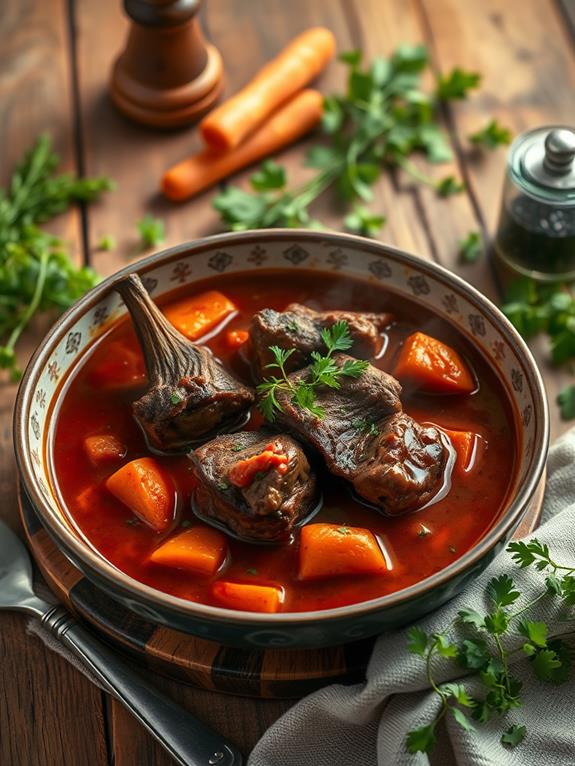Is Oxtail Safe to Eat
Oxtail is safe to eat when you follow proper handling and cooking guidelines. You should cook it to an internal temperature of 145°F (62.8°C) and let it rest for three minutes before serving. This guarantees harmful bacteria are eliminated. To prevent cross-contamination, use separate cutting boards for raw meat and wash your hands thoroughly after handling. Oxtail offers nutritional benefits, including high protein content and essential minerals. However, it's important to consume it in moderation due to its higher saturated fat content. By practicing good food safety habits and cooking methods, you can enjoy this flavorful cut without concern. Understanding the facts can help dispel common misconceptions about oxtail consumption.
This post may contain affiliate links. If you make a purchase through these links, I may earn a commission at no additional cost to you. Additionally, portions of this post may be generated using artificial intelligence (AI) technology. While we strive for accuracy, please be aware that AI-generated content may not always be perfect and should be fact-checked when necessary.
The Spatula Scoops
- Oxtail is safe to eat when cooked to an internal temperature of 145°F (62.8°C) and allowed to rest for three minutes.
- Proper handling practices, including separate cutting boards and thorough hand washing, prevent cross-contamination risks.
- Oxtail offers nutritional benefits like protein, collagen, and essential minerals when consumed as part of a balanced diet.
- Slow cooking methods enhance tenderness and ensure safety, typically requiring 3-4 hours of cooking time.
- Fears about neurological diseases are unfounded when oxtail is sourced from reputable suppliers and cooked properly.
Understanding Oxtail Safety Concerns

Three key factors guarantee oxtail safety: proper cooking temperature, handling techniques, and storage practices. When it comes to cooking oxtail, you'll need to make sure it reaches an internal temperature of 145°F (62.8°C). This vital step eliminates harmful bacteria that could cause foodborne illnesses. As with any meat, it's important to remember the food safety guidelines regarding time and temperature to prevent contamination. After cooking, let the meat rest for at least three minutes before serving.
Food safety doesn't stop at cooking. You must handle raw oxtail with care to prevent cross-contamination. Use separate cutting boards and utensils for meat, and wash your hands thoroughly after handling. When shopping, select oxtail with a deep red color and check for intact packaging.
Proper storage is essential for maintaining oxtail safety. Refrigerate leftovers within two hours of cooking and consume them within 3-4 days. For longer storage, freeze the oxtail for up to 6 months. This preserves both safety and quality.
Proper Handling and Preparation

Building on the safety guidelines mentioned earlier, proper handling and preparation of oxtail are key to guaranteeing a safe and delicious meal. When you're shopping for oxtail, choose pieces with a deep red color from reputable sources. Avoid any that appear grayish or brown, as this may indicate spoilage. Once you've got your oxtail home, it's vital to handle it safely to prevent cross-contamination.
| Step | Action | Purpose |
|---|---|---|
| 1 | Use separate cutting boards | Prevent cross-contamination |
| 2 | Wash hands thoroughly | Maintain hygiene |
| 3 | Cook to 145°F (62.8°C) | Eliminate harmful bacteria |
| 4 | Rest for 3 minutes | Guarantee safe consumption |
When cooking oxtail, it's important to reach the proper internal temperature. Use a meat thermometer to verify it's cooked to 145°F (62.8°C), then let it rest for at least three minutes before serving. This resting period allows the temperature to stabilize and guarantees any remaining bacteria are eliminated. If you have leftovers, store them promptly within two hours. You can refrigerate cooked oxtail for 3-4 days or freeze it for up to 6 months for safe consumption later.
Nutritional Benefits of Oxtail

While oxtail may not be the first cut of meat that comes to mind for health-conscious eaters, it actually packs a surprising nutritional punch. Its nutritional profile is quite impressive, offering a range of benefits that might make you reconsider this often-overlooked cut. The importance of traditional food sources, like oxtail, can be paralleled with the rich tapestry of Cambodian culture, where diverse culinary practices are integral to social traditions, much like the intricate fishing community adaptations seen around Tonle Sap Lake.
You'll find that oxtail is a good source of protein, providing about 30 grams per 100-gram serving. This makes it an excellent choice for muscle repair and overall body function. It's also rich in collagen, which can support your joint health and skin elasticity when you consume it regularly.
If you opt for grass-fed oxtail, you'll get the added benefit of increased omega-3 fatty acids and CLA, which contribute to heart health. Additionally, oxtail is a good source of essential minerals like iron, zinc, and phosphorus, supporting your immune system and bone strength.
However, it's important to remember that moderation is key. While oxtail offers numerous nutritional benefits, it's also relatively high in saturated fat and cholesterol. So, while it can be a healthy addition to your diet, you'll want to balance it with other lean protein sources and plenty of fruits and vegetables.
Cooking Methods for Safe Consumption

To guarantee oxtail is safe to eat, you'll need to pay close attention to cooking methods and temperatures. Make certain you cook oxtail to an internal temperature of at least 145°F (62.8°C) to eliminate harmful bacteria, as improper cooking can lead to significant health risks similar to those associated with ground beef. Use a meat thermometer to check for doneness, especially when cooking larger cuts or using slow cooker methods. For example, recommended cooking temperatures are vital for assuring meat safety.
Slow cooking techniques, such as braising or simmering, are ideal for oxtail. You'll need to cook it for 3-4 hours to break down the collagen and achieve tender meat. This extended cooking time not only improves flavor but also secures safety. After cooking, let the oxtail rest for at least three minutes to maintain safety standards and enhance taste.
Remember to clean all surfaces and utensils thoroughly during preparation to prevent cross-contamination. By following these guidelines, you'll guarantee your oxtail is not only delicious but also safe to consume. The hours of cooking required for oxtail might seem lengthy, but they're essential for both safety and flavor. With proper cooking methods, you can enjoy this flavorful cut of meat without worry.
Addressing Common Misconceptions

Many misconceptions surround the safety of eating oxtail, but it's important to separate fact from fiction. You might have heard concerns about neurological diseases or food safety issues associated with oxtail. However, these fears are largely unfounded when you source your oxtail from reputable suppliers and follow proper cooking practices. For instance, if you're cooking oxtail for a family gathering, consider using an appliance like the Philips Premium Air Fryer XXL to achieve flavorful results while minimizing unhealthy fats. Look for oxtail from trusted sources and cook it thoroughly to an internal temperature of 145°F (62.8°C). This guarantees you'll eliminate harmful bacteria while enjoying its rich taste. The worries about Mad Cow Disease are primarily linked to unsafe farming practices, not the consumption of properly sourced and prepared oxtail.
Cross-contamination is a real concern, but it's easily managed. Use separate cutting boards and utensils for oxtail and other foods. Remember, these precautions apply to all meats, not just oxtail. By following basic food safety guidelines, such as proper refrigeration of leftovers and thorough cooking, you can safely enjoy oxtail without worry. Don't let misconceptions deter you from experiencing this flavorful cut of beef. With the right approach, oxtail can be a safe and delicious addition to your culinary repertoire.
Frequently Asked Questions
Is Oxtail Healthy to Eat?
You might think oxtail's just a fatty indulgence, but you'd be surprised. It's actually quite nutritious. Oxtail's packed with protein, supporting muscle repair and overall health. It's rich in collagen, promoting joint and skin health. You'll also find essential minerals like iron and zinc, boosting your immune system and metabolism. However, it's high in saturated fat and cholesterol, so moderation is key. Opt for grass-fed oxtail when possible, as it offers higher levels of beneficial omega-3 fatty acids and CLA.
Is Oxtail Bad for Your Stomach?
Oxtail isn't inherently bad for your stomach. In fact, when cooked properly, it can be beneficial. The high collagen content may support gut health and aid digestion. However, if you're sensitive to rich or fatty foods, you might experience discomfort due to its higher saturated fat content. Moderation is key. Verify it's cooked to the correct internal temperature to avoid foodborne illnesses. If you have specific dietary concerns, it's best to consult with a healthcare professional before adding oxtail to your diet.
Why Do You Soak Oxtail Before Cooking?
Imagine your oxtail as a sponge, soaking up flavors and shedding impurities. You'll want to soak it before cooking to enhance its taste and texture. This process helps remove excess blood and any grit, resulting in a cleaner flavor. You're also tenderizing the meat, making it more palatable. Some cooks use salt or vinegar in the soaking water, which can further improve the meat's quality. After soaking, don't forget to rinse thoroughly to remove any lingering salt or impurities.
Do You Eat the Meat From the Oxtail?
Yes, you do eat the meat from the oxtail. When you cook oxtail properly, you'll find tender, flavorful meat attached to the bones. It's rich in collagen, which breaks down during slow cooking, resulting in a gelatinous texture. You'll want to separate the meat from the bones before eating. The meat is often used in stews, soups, and braised dishes. Don't forget to savor the marrow inside the bones for an extra boost of flavor and nutrition.





